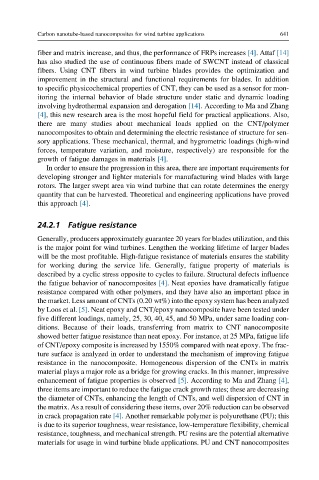Page 698 - Polymer-based Nanocomposites for Energy and Environmental Applications
P. 698
Carbon nanotube-based nanocomposites for wind turbine applications 641
fiber and matrix increase, and thus, the performance of FRPs increases [4]. Attaf [14]
has also studied the use of continuous fibers made of SWCNT instead of classical
fibers. Using CNT fibers in wind turbine blades provides the optimization and
improvement in the structural and functional requirements for blades. In addition
to specific physicochemical properties of CNT, they can be used as a sensor for mon-
itoring the internal behavior of blade structure under static and dynamic loading
involving hydrothermal expansion and derogation [14]. According to Ma and Zhang
[4], this new research area is the most hopeful field for practical applications. Also,
there are many studies about mechanical loads applied on the CNT/polymer
nanocomposites to obtain and determining the electric resistance of structure for sen-
sory applications. These mechanical, thermal, and hygrometric loadings (high-wind
forces, temperature variation, and moisture, respectively) are responsible for the
growth of fatigue damages in materials [4].
In order to ensure the progression in this area, there are important requirements for
developing stronger and lighter materials for manufacturing wind blades with large
rotors. The larger swept area via wind turbine that can rotate determines the energy
quantity that can be harvested. Theoretical and engineering applications have proved
this approach [4].
24.2.1 Fatigue resistance
Generally, producers approximately guarantee 20 years for blades utilization, and this
is the major point for wind turbines. Lengthen the working lifetime of larger blades
will be the most profitable. High-fatigue resistance of materials ensures the stability
for working during the service life. Generally, fatigue property of materials is
described by a cyclic stress opposite to cycles to failure. Structural defects influence
the fatigue behavior of nanocomposites [4]. Neat epoxies have dramatically fatigue
resistance compared with other polymers, and they have also an important place in
the market. Less amount of CNTs (0.20 wt%) into the epoxy system has been analyzed
by Loos et al. [5]. Neat epoxy and CNT/epoxy nanocomposite have been tested under
five different loadings, namely, 25, 30, 40, 45, and 50 MPa, under same loading con-
ditions. Because of their loads, transferring from matrix to CNT nanocomposite
showed better fatigue resistance than neat epoxy. For instance, at 25 MPa, fatigue life
of CNT/epoxy composite is increased by 1550% compared with neat epoxy. The frac-
ture surface is analyzed in order to understand the mechanism of improving fatigue
resistance in the nanocomposite. Homogeneous dispersion of the CNTs in matrix
material plays a major role as a bridge for growing cracks. In this manner, impressive
enhancement of fatigue properties is observed [5]. According to Ma and Zhang [4],
three items are important to reduce the fatigue crack growth rates; these are decreasing
the diameter of CNTs, enhancing the length of CNTs, and well dispersion of CNT in
the matrix. As a result of considering these items, over 20% reduction can be observed
in crack propagation rate [4]. Another remarkable polymer is polyurethane (PU); this
is due to its superior toughness, wear resistance, low-temperature flexibility, chemical
resistance, toughness, and mechanical strength. PU resins are the potential alternative
materials for usage in wind turbine blade applications. PU and CNT nanocomposites

